Why Should We Change to Digital TV?

Data about TV in Indonesia
In this advanced era, television is one of the electronic media that has a great power in influencing society. With various forms of features ranging from visual, sound, and text, television is still considered as an information centre for most people in the world, including here in Indonesia. Not only that, television has become one of the best entertainment sources for Indonesia’s society from year to year. As can be seen from the chart below, data collected by the Central Bureau of Statistics (BPS), shows the fact that the percentage of Indonesians who watch television is at a high rate every year from 2019 to 2021.
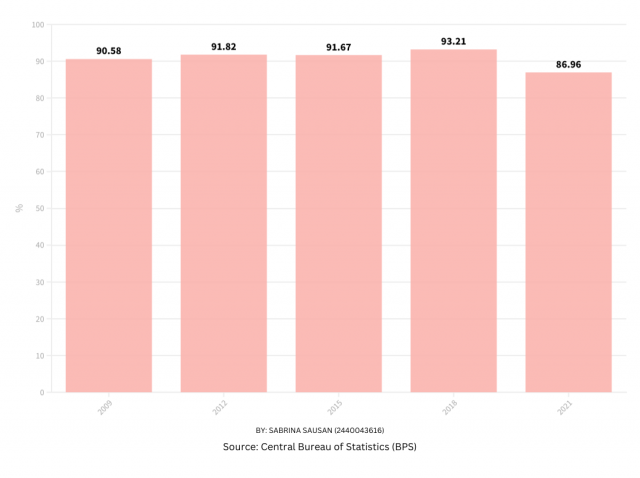
According to the same research by the Central Bureau of Statistics (BPS), it was accumulated that overall TV viewers are mostly women with a total percentage of 87,80%, while men at 86,12%. From this research, it could be concluded that television owns a very essential role within Indonesian society. Furthermore, another research that has proven the significance of television in Indonesia is through data published by KataData.Co.Id that indicates how Indonesian viewers tend to spend more time watching television rather than online streaming.
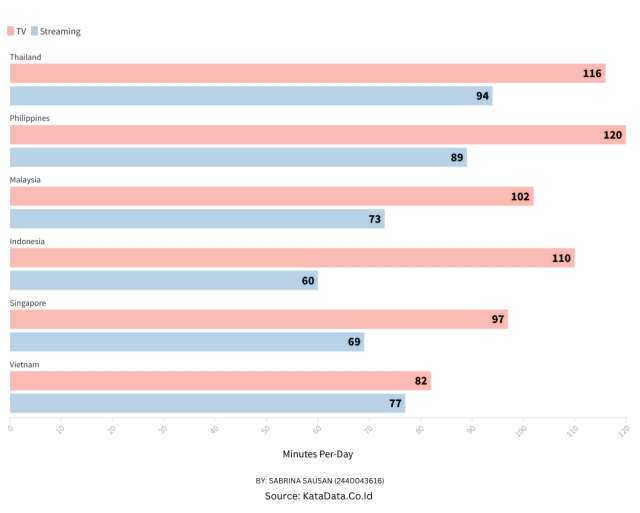
From the chart above, it can be perceived that Indonesians spend 1 hour and 50 minutes a day watching television while spending less time streaming. Indonesia placed in the top three with the duration spent watching TV in South East Asia. All data given above has clearly illustrated how television has become part of the daily life of Indonesians.
The History of TV in Indonesia
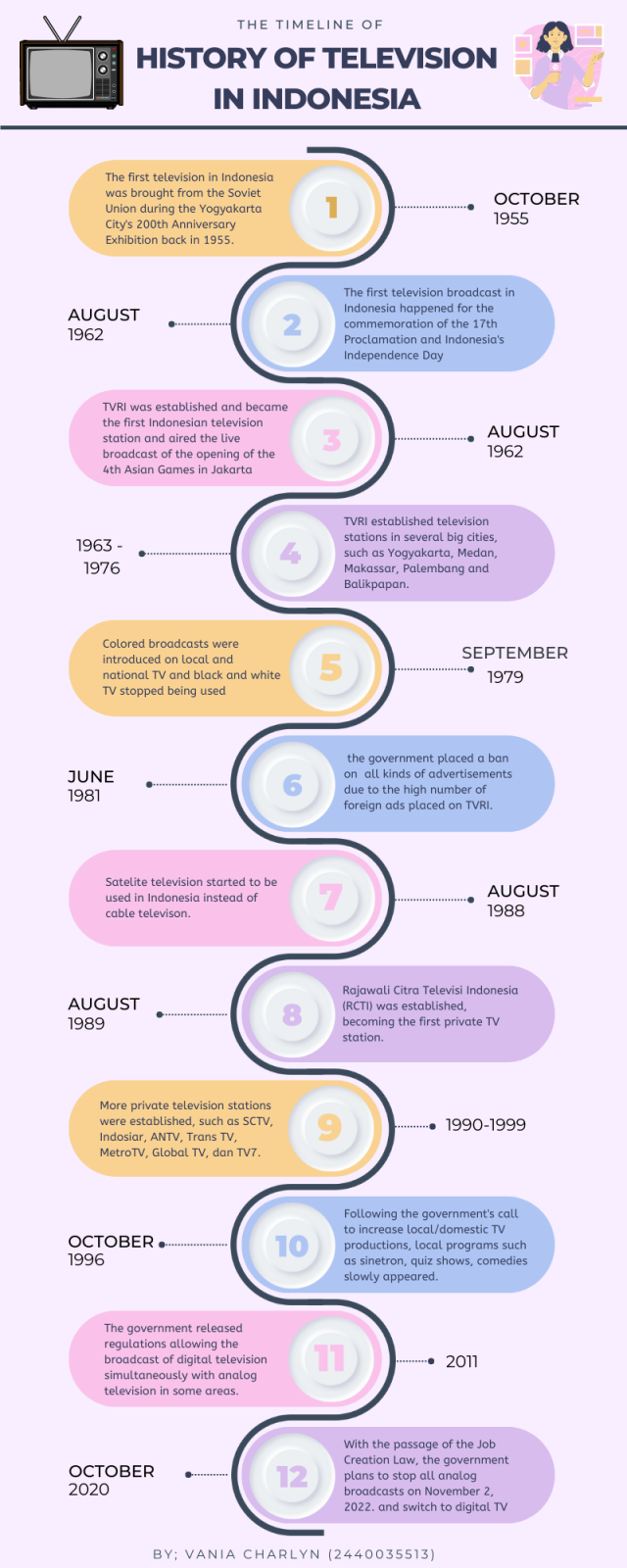
The first television in Indonesia was brought from the Soviet Union during the Yogyakarta City 200th Anniversary Exhibition back in 1955. The first television broadcast in Indonesia was on August 17, 1962, simultaneously with the celebration of the 17th Proclamation of the Republic of Indonesia, which broadcasted the independence day commemoration ceremony. Just 7 days later, Televisi Republik Indonesia (TVRI) was established and became the first Indonesian television station. On the very same day, TVRI aired the live broadcast of the opening of the 4th Asian Games which was held at Senayan, Jakarta.
In the first year of broadcasting, TVRI was able to broadcast to 10,000 television owners in Indonesia. Then from 1963 to 1976, TVRI established television stations in several big cities, such as Yogyakarta, Medan, Makassar, Palembang, and Balikpapan. TVRI previously only provided black and white broadcasts until finally, on September 1, 1979, colored broadcasts were introduced on local and national TV. In 1981, the government placed a ban on advertisements due to the high number of foreign advertisements placed on TVRI as there were many criticisms and complaints coming from the public.
At the beginning of its emergence, television was used to broadcast important events, such as the Asian Games or the Indonesian Independence Ceremony, and spread the news. Along with the changing times, television programs are becoming more varied with television programs that are more entertaining than educational elements. On August 8th, 1988, satellite television started to be used in Indonesia instead of cable television.
As the only TV station in Indonesia, the government found that TVRI alone couldn’t fulfill all the broadcast needs of the public. Seeing other neighboring countries like Malaysia and the Philippines that have successfully operated their private television channels, President Suharto allowed the establishment of a private television channel. On 24 August 1989, Rajawali Citra Televisi Indonesia (RCTI) was established, becoming the first private TV station.
A year later on August 24, a third television station was born again, namely Surya Citra Televisi (SCTV). From 1990 to 1999, more private television stations were established, such as SCTV, Indosiar, ANTV, Trans TV, MetroTV, Global TV, and TV7. At the beginning of its presence, private television was flooded with imported programs, imported drama series, animated series, films, and others. This triggered a play on the names of television stations, such as “Rajawali Citra Television Indonesia” and “Indosiar Visual Mandiri”. During the early 1990s, only Western series was popular.
However, entering the mid-1990s, Mandarin Series and Latin American telenovelas started to attract more Indonesian viewers. In 1996, following the government’s call to increase local program content and domestically produced advertisements, local programs such as sinetron, quiz shows, comedies, and news slowly appeared. In 2011, the government released regulations allowing the broadcast of digital television simultaneously with analog television in some areas. In October 2020, with the passage of the Job Creation Law, the government plans to stop all analog broadcasts on November 2, 2022, and start the socialization for the public to switch to digital television instead.
Indonesian Government Efforts in Transition to Digital TV
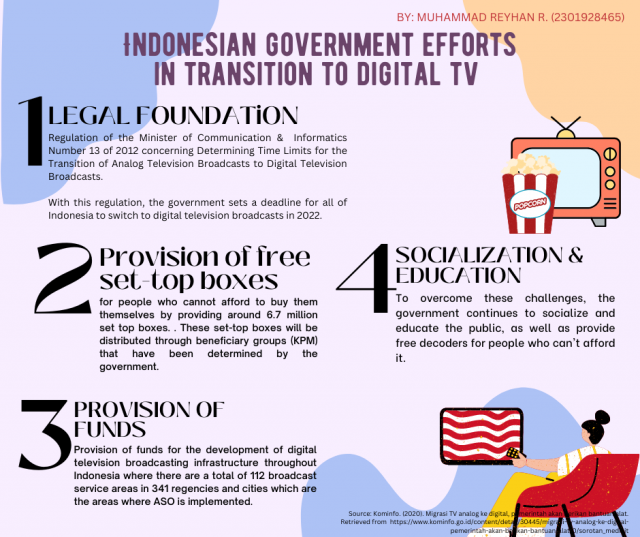
The Indonesian government has made various efforts to switch to digital television broadcasting. One of the steps taken was to issue Regulation of the Minister of Communication and Informatics Number 13 of 2012 concerning Determining Time Limits for the Transition of Analog Television Broadcasts to Digital Television Broadcasts. With this regulation, the government sets a deadline for all of Indonesia to switch to digital television broadcasts in 2022.
In addition, the government also issued several other policies to support the transition to digital television broadcasting, including:
- Provision of free set-top boxes for people who cannot afford to buy them themselves by providing around 6.7 million set-top boxes. These set-top boxes were distributed through beneficiary groups (KPM) that had been determined by the government.
- Provision of digital television trial broadcasts in several areas as a trial before digital television broadcasts are officially launched throughout Indonesia and operate as many as 728 analog TVs in Indonesia and build TVRI MUX networks in 34 provinces.
- Provision of funds for the development of digital television broadcasting infrastructure throughout Indonesia where there are a total of 112 broadcast service areas in 341 regencies and cities which are the areas where ASO is implemented. The ASO Phase I area which is scheduled for April 30 2022, includes the City of Sabang (Aceh), the City of Banda Aceh (Aceh), Karo Regency (North Sumatra), Padang City (West Sumatra), Bukittinggi City (West Sumatra), Garut City (West Java), Cilegon City (Banten), Banyumas Regency (Central Java), Sampang Regency (East Java), Denpasar City (Bali), Kupang Regency (NTT), Minahasa Regency (North Sulawesi), Samarinda City (East Kalimantan), Gowa City (South Sulawesi), Mimika Regency (Papua ), and Manokwari Regency (West Papua).
- Providing socialization and education to the public about the importance of switching to digital television broadcasts.
With the various policies that have been issued, it is hoped that the transition to digital television broadcasting in Indonesia can run smoothly and that Indonesian people will soon be able to enjoy better broadcast quality. However, there are several challenges that must be faced in this transition process, including the low level of public awareness of the importance of switching to digital television broadcasts, as well as limited public access to devices that are compatible with digital television broadcasts. .
To overcome these challenges, the government continues to socialize and educate the public, as well as provide free decoders for people who can’t afford them. It is hoped that the Indonesian people will soon be able to enjoy better and more efficient digital television broadcasts.
The End of the Analog TV Era in Indonesia
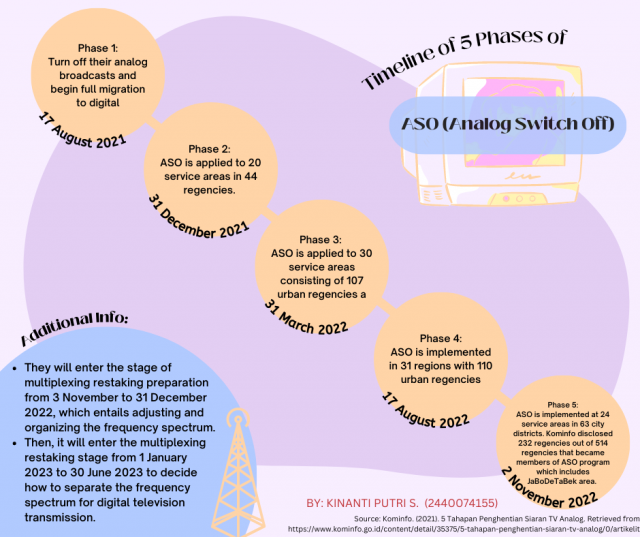
From 2 November 2022, the Ministry of Communication and Informatics (Kominfo) will stop broadcasting analog television (TV) gradually. The transition from analog TV to digital TV is called the ASO (Analog Switch Off) program. There were 5 phases of the ASO program that was planned to be executed on 17 August 2021.
The first phase was to turn off their analog broadcasts and begin full migration to digital. After completing phase 1, phase 2 of ASO will be carried out on December 31, 2021, in 20 service areas in 44 regencies. Then, phase 3 took place on 31 March 2022 in 30 service areas consisting of 107 urban regencies and phase 4 started on 17 August 2022 in 31 regions with 110 urban regencies. Phase 5, or the last stage was carried out on 2 November 2022, affecting 24 service areas in 63 city districts. In total, on 2 November 2022, Kominfo disclosed 232 regencies out of 514 regencies that became members of ASO program which includes the JaBoDeTaBek area as well.
Additionally, ASO entered the stage of multiplexing restacking preparation from 3 November to 31 December 2022, which entailed adjusting and organizing the frequency spectrum. The spectrum utilized for broadcasting and cellular communication was decided. Then it continues with the multiplexing restacking stage from 1 January 2023 to 30 June 2023 to decide how to separate the frequency spectrum for digital television transmission.
The remaining 112 Mhz frequency spectrum is used to improve cellular communications once it has been found. Although there are still many big cities such as Surabaya and Makassar that utilize analog TV or broadcast. Since there are still some areas or television channel companies that are not registered in the ASO program due to being in opposition to the transition, Kominfo insists that every area should oblige with this program for the benefit of the national television industry and community service.
The government has the right to revoke the license of private broadcasting institutions that are reluctant to register themselves in the ASO program. This could be done because of the policy has been stated in Article 60A Section 2 Law of the Republic of Indonesia No. 11 of 2020 on Job Creation. The law mandates that the migration of analog television to digital must be completed no later than two years after this law comes into force.
The transition was done in order to catch up with other ASEAN countries in the field of digital TV broadcasting and also it would save frequency bands so that they could be allocated for other uses, such as the 5G network. As a result, Indonesia’s 5G services will be at their best, helping to strengthen the country’s economy and add new jobs in the age of Industry 4.0. Ultimately, Indonesia’s digital transformation involves a competitive digital transformation that also incorporates technological advancements.
In terms of the statistic on the increasing amount of digital TV usage across 11 big cities in Indonesia, The Nielsen Company Indonesia, a company known for audience measurement as well as data and analytics, conducted a survey under the name ‘Trend of Digital Ready Per City’. The results are shown in the data below.
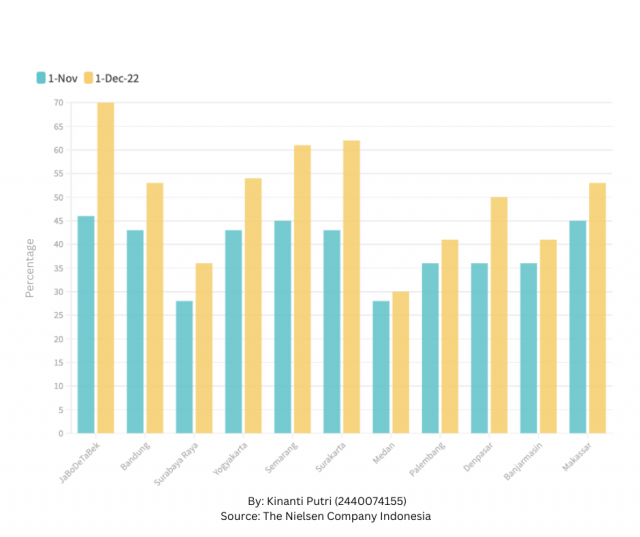
The data has shown a significant difference in the rising percentage of each city that uses digital TV during a month at the end of the year 2022. According to Kominfo, the number increases due to the effect of the World Cup event in December 2022.
Comparison Between Analog TV and Digital TV
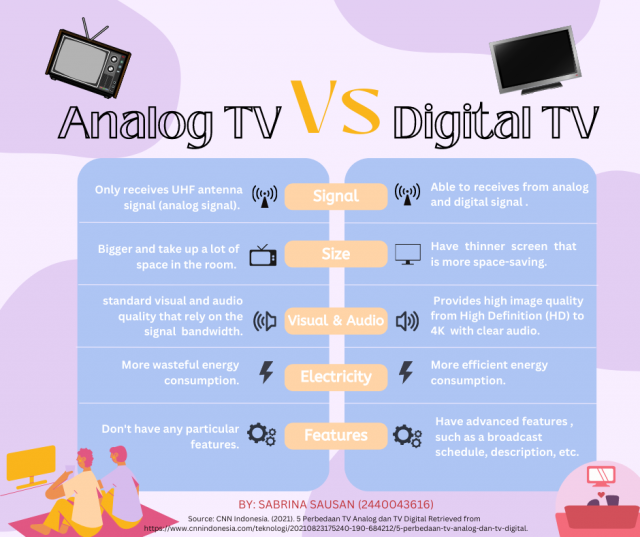
Signal
The first comparison between analog and digital TV is in their signals. The analog TV signal is limited because it only receives UHF antenna signals. A UHF antenna, also known as an Ultra High-Frequency antenna, is used to receive TV station signals. However, due to the fact that UHF antennas are still analog, they are much more susceptible to interference and distortion when they are placed far from the TV station or when there is bad weather. Meanwhile, digital TV transmitter signals are more stable, and not affected by weather conditions or distance. Furthermore, signals from both digital and analog sources can be received by digital TV.
Size
The second comparison in terms of size is that analog TV itself uses cathode ray tubes, which of course makes analog TV look much bigger and take up a lot of space in the room. Meanwhile, digital TV uses a flat panel screen made from several high-tech devices such as LCD, Plasma, and LED which is more space-saving.
Visual and audio quality
The third comparison that distinguishes differences between analog and digital TV is its visual and audio quality. Analog TV has a standard visual and audio quality caused by the limited bandwidth that it possesses. If the distance between TV stations and UHF antennas is closer, then the visual and audio presentation will be at its finest. If the distance is too great, the visual and audio quality will suffer, with the visual becoming hazy with noise. Additionally, compared to analog TV, the visual and audio quality on digital TV is better because it has a wider bandwidth. Digital TV is also supported with the 16:9 broadcast format, which provides high image quality ranging from High Definition (HD) to 4K.
Electricity consumption
As aforementioned, analog TV uses cathode ray tubes, which makes electric consumption much higher. Digital TV, on the other hand, has a thinner screen that is more energy-efficient.
Features
The final comparison between analog and digital television is based on features. Founded in the past, when technology was not yet developed, analog TV did not have any particular features. So, the main usage of analog TV is to just watch live broadcasts from TV stations. In comparison, digital TV offers various advanced features for its users, such as a broadcast schedule, description, and many more.
How to Switch Analog TV to Digital TV
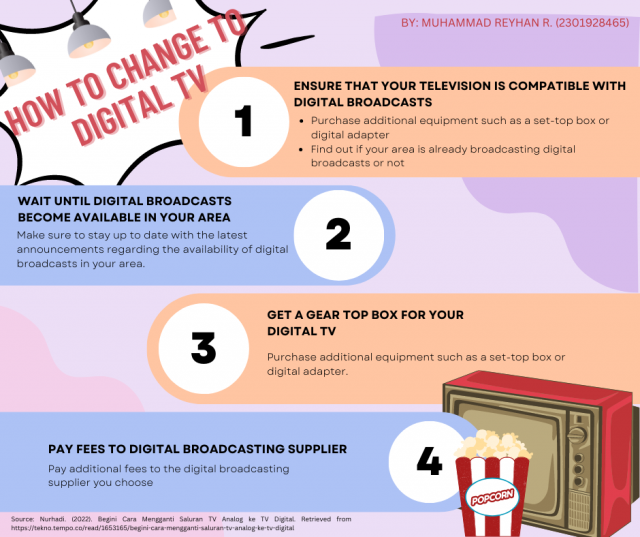
Indonesia should switch to digital television as this will improve the picture and sound quality displayed. In addition, this technology is also more efficient in the use of frequency spectrum, so that it can accommodate more television channels on the same network.
To switch to digital television, you must first ensure that your television is compatible with digital broadcasts. If not, you may need to purchase additional equipment such as a set-top box or digital adapter. Next, you need to find out if your area is already broadcasting digital broadcasts or not. If so, you can follow the setup instructions provided by the digital broadcasting supplier to enable digital broadcasting on your television.
If your area does not broadcast digital broadcasts yet, you will have to wait until digital broadcasts become available in your area. The Indonesian Ministry of Communication and Information has announced that all of Indonesia will switch to digital broadcasting in 2022. So, make sure to stay up to date with the latest announcements regarding the availability of digital broadcasts in your area.
Switching to digital television also requires you to pay additional fees to the digital broadcasting supplier you choose. However, this cost comes with better picture and sound quality and a wider selection of channels.
So, in the long term, switching to digital television will be a wise decision for Indonesians. Apart from improving broadcast quality, this technology will also bring many other benefits such as efficient use of the frequency spectrum and a wider selection of channels. Be sure to stay up to date with the latest announcements about the availability of digital broadcasts in your area and don’t hesitate to switch to digital television when it becomes available.
This article is written by B2024 students:
- Sabrina Sausan
- Vania Charlyn
- Kinanti Putri S
- Muhammad Reyhan Riansyah
Edited by Lily El Ferawati

